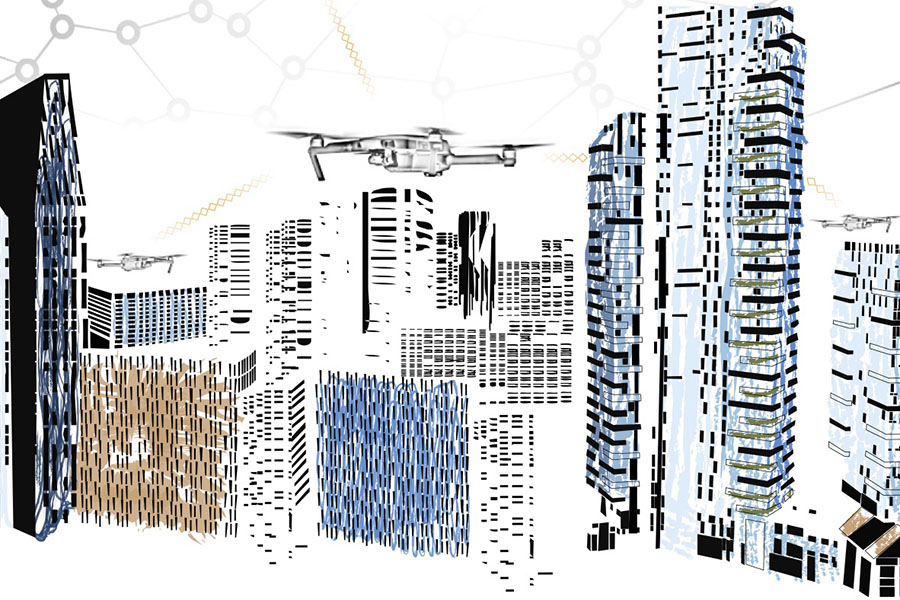A practical solution to the Federal Aviation Administration's proposed Remote ID regulations

Late in 2019, the Federal Aviation Administration (FAA) dropped a much-awaited Notice of Proposed Rulemaking (NPRM), detailing rules for a Remote ID (RID) system of unmanned aircraft. The new regulation has potential to open the sky for commercial drone services, such as aerial package delivery. While most of the UAS community supports the need for a RID system, the NPRM has received a mixed response from the community. Implementation of the proposed RID system faces difficult technology challenges. For example, besides broadcasting RID information, the RID systems need to upload the same messages to a cloud database as well. If performed with the existing internet service and coverage (through cellular data plans), satisfying this requirement can prove quite costly and impossible in some areas.
We believe that our proposed protocol, Traffic Information Exchange Network (TIEN), can provide a cheaper and secure alternative to satisfy the RID system requirements.
TIEN is a relay-based broadcasting protocol that can enable data sharing between multiple devices. The protocol works similar to “gossip protocol” where a device keeps listening to the neighboring broadcasted messages and whenever it receives a message, it adds its own information on top of the old one and broadcasts the new message. This mechanism enables two distant devices to share information with each other through a device in between. This is especially important in an urban environment where information between two relatively closer drones can be blocked due to obstacles, such as skyscrapers. Relay mechanism ensures that the critical information is received if reasonable density of the devices in the area is maintained.
Lack of security and data integrity check have always been a point of major criticism for the ADS-B system, used for broadcasting information in commercial aviation. TIEN development team takes some inspiration from blockchain technologies to tackle this issue. The TIEN protocol design includes various cryptographic checks to ensure the relayed messages are trustworthy and intact. These checks can tell how a specific message has propagated through the network. TIEN leverages the propagation history and identifies irregularities to single-out bad actors.
UAS operators have raised privacy-related concerns as the pilot’s location is supposed to be included in the data packet. TIEN protocol is developed with keeping these concerns in mind and, thus, provides an option to send information in both public and private (encrypted) manner in the same data packet. For example, before any flight, a pilot can connect to FAA’s server to receive a special key to encrypt their location information. Then, this information can be kept private from general public while still allowing access to essential entities, such as law enforcement agencies.
Finally, regarding the economic feasibility of such implementation, TIEN system includes two categories of devices: onboard devices (RID system) and ground devices. Drones should carry an Onboard device in accordance with FAA’s RID regulation while Ground devices are carried with drone operators or are deployed across a city. Ground devices provide a way to upload received messages to FAA’s database to satisfy the RID requirement without needing an expensive cellular plan.
The power of TIEN system is based on its protocol and, thus, it is not limited to any radio communication technology. TIEN development team recently developed a prototype system that uses a regular off-the-shelf Wi-Fi dongle (for broadcasting) and Raspberry Pi 3 as an onboard computer. The cost of equipment for this prototyping system, capable of satisfying every FAA RID requirement, is less than $80. Mass production and development of specialized equipment can reduce the cost even further. With TIEN technology, drone operators do not need an expensive monthly data plan and can just acquire RID systems without worrying about the data subscription costs. TIEN team successfully performed a series of experiments at the end of 2019 to demonstrate the relay mechanism. The experimental study is supported through NASA’s University Student Research Challenge program and a detailed analysis will be published in the latter half of this year.
To conclude, a blockchain-inspired data transmission protocol has been developed, to realize the remote ID system for drone operators. TIEN system can provide a secure and economically feasible solution, that is in accordance to the proposed FAA Remote ID regulations.
Hsun Chao, Ph.D student, School of Aeronautics and Astronautics
Apoorv Maheshwari, Ph.D student, School of Aeronautics and Astronautics
For more information about TIEN system, contact Hsun Chao and Apoorv Maheshwari
The views and opinions expressed in this blog are those of the authors and do not necessarily reflect the official policy or position of Purdue University or the School of Aeronautics and Astronautics.
